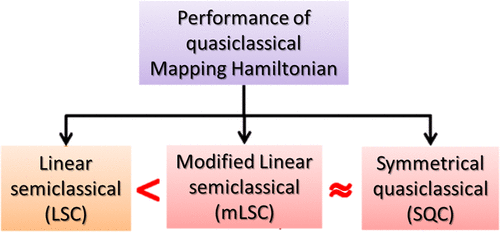当前位置:
X-MOL 学术
›
J. Chem. Theory Comput.
›
论文详情
Our official English website, www.x-mol.net, welcomes your
feedback! (Note: you will need to create a separate account there.)
Benchmarking Quasiclassical Mapping Hamiltonian Methods for Simulating Electronically Nonadiabatic Molecular Dynamics.
Journal of Chemical Theory and Computation ( IF 5.7 ) Pub Date : 2020-04-14 , DOI: 10.1021/acs.jctc.9b01267 Xing Gao 1 , Maximilian A C Saller 2 , Yudan Liu 1 , Aaron Kelly 3 , Jeremy O Richardson 2 , Eitan Geva 1
Journal of Chemical Theory and Computation ( IF 5.7 ) Pub Date : 2020-04-14 , DOI: 10.1021/acs.jctc.9b01267 Xing Gao 1 , Maximilian A C Saller 2 , Yudan Liu 1 , Aaron Kelly 3 , Jeremy O Richardson 2 , Eitan Geva 1
Affiliation

|
Quasi-classical mapping Hamiltonian methods have recently emerged as a promising approach for simulating electronically nonadiabatic molecular dynamics. The classical-like dynamics of the overall system within these methods makes them computationally feasible, and they can be derived based on well-defined semiclassical approximations. However, the existence of a variety of different quasi-classical mapping Hamiltonian methods necessitates a systematic comparison of their respective advantages and limitations. Such a benchmark comparison is presented in this paper. The approaches compared include the Ehrenfest method, the symmetrical quasi-classical (SQC) method, and five variations of the linearized semiclassical (LSC) method, three of which employ a modified identity operator. The comparison is based on a number of popular nonadiabatic model systems; the spin-boson model, a Frenkel biexciton model, and Tully's scattering models 1 and 2. The relative accuracy of the different methods is tested by comparing with quantum-mechanically exact results for the dynamics of the electronic populations and coherences. We find that LSC with the modified identity operator typically performs better than the Ehrenfest and standard LSC approaches. In comparison to SQC, these modified methods appear to be slightly more accurate for condensed phase problems, but for scattering models there is little distinction between them.
中文翻译:

基准准古典映射哈密顿方法,用于模拟电子非绝热分子动力学。
准经典映射哈密顿方法最近已经成为模拟电子非绝热分子动力学的一种有前途的方法。这些方法中整个系统的经典动力学使它们在计算上可行,并且可以基于定义明确的半经典近似导出它们。但是,存在各种不同的准经典映射哈密顿方法,需要对它们各自的优点和局限性进行系统比较。本文提供了这样的基准比较。比较的方法包括Ehrenfest方法,对称准经典(SQC)方法以及线性化半经典(LSC)方法的五个变体,其中三个变体采用了改进的身份算子。比较是基于许多流行的非绝热模型系统进行的;自旋玻色子模型,Frenkel双激子模型以及Tully散射模型1和2。通过与电子机械动力学和相干性的量子力学精确结果进行比较,测试了不同方法的相对精度。我们发现,带有修改后的身份运算符的LSC通常比Ehrenfest和标准LSC方法表现更好。与SQC相比,这些改进的方法对于凝聚相问题似乎更为准确,但是对于散射模型,它们之间几乎没有区别。通过与电子力学和相干性动力学的量子力学精确结果进行比较,测试了不同方法的相对精度。我们发现,带有修改后的身份运算符的LSC通常比Ehrenfest和标准LSC方法表现更好。与SQC相比,这些改进的方法对于凝聚相问题似乎更准确,但是对于散射模型,它们之间几乎没有区别。通过与电子力学和相干性动力学的量子力学精确结果进行比较,测试了不同方法的相对精度。我们发现,带有修改后的身份运算符的LSC通常比Ehrenfest和标准LSC方法表现更好。与SQC相比,这些改进的方法对于凝聚相问题似乎更准确,但是对于散射模型,它们之间几乎没有区别。
更新日期:2020-03-31
中文翻译:

基准准古典映射哈密顿方法,用于模拟电子非绝热分子动力学。
准经典映射哈密顿方法最近已经成为模拟电子非绝热分子动力学的一种有前途的方法。这些方法中整个系统的经典动力学使它们在计算上可行,并且可以基于定义明确的半经典近似导出它们。但是,存在各种不同的准经典映射哈密顿方法,需要对它们各自的优点和局限性进行系统比较。本文提供了这样的基准比较。比较的方法包括Ehrenfest方法,对称准经典(SQC)方法以及线性化半经典(LSC)方法的五个变体,其中三个变体采用了改进的身份算子。比较是基于许多流行的非绝热模型系统进行的;自旋玻色子模型,Frenkel双激子模型以及Tully散射模型1和2。通过与电子机械动力学和相干性的量子力学精确结果进行比较,测试了不同方法的相对精度。我们发现,带有修改后的身份运算符的LSC通常比Ehrenfest和标准LSC方法表现更好。与SQC相比,这些改进的方法对于凝聚相问题似乎更为准确,但是对于散射模型,它们之间几乎没有区别。通过与电子力学和相干性动力学的量子力学精确结果进行比较,测试了不同方法的相对精度。我们发现,带有修改后的身份运算符的LSC通常比Ehrenfest和标准LSC方法表现更好。与SQC相比,这些改进的方法对于凝聚相问题似乎更准确,但是对于散射模型,它们之间几乎没有区别。通过与电子力学和相干性动力学的量子力学精确结果进行比较,测试了不同方法的相对精度。我们发现,带有修改后的身份运算符的LSC通常比Ehrenfest和标准LSC方法表现更好。与SQC相比,这些改进的方法对于凝聚相问题似乎更准确,但是对于散射模型,它们之间几乎没有区别。











































 京公网安备 11010802027423号
京公网安备 11010802027423号